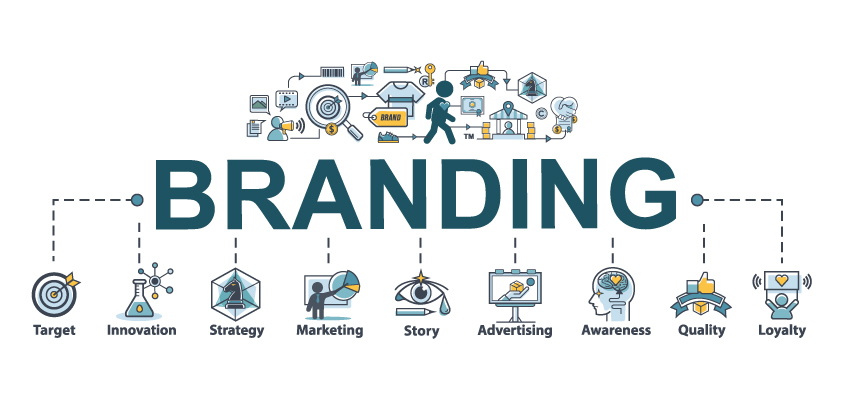The Essential Elements of Robust Branding Every Service Should Know
The Essential Elements of Robust Branding Every Service Should Know
Blog Article
The Power of Durable Branding: An Overview to Enhancing Your Brand name's Strength
In today's competitive industry, the relevance of durable branding can not be overemphasized. A distinct brand name identity not only establishes a firm apart but likewise cultivates trust fund and loyalty among customers. By effectively leveraging emotional connections and preserving consistency throughout numerous channels, companies can grow a solid visibility that resonates with their target audience. Several organizations ignore critical techniques that can better amplify their brand name's stamina. As we explore these crucial elements, it becomes clear that understanding the subtleties of branding might hold the trick to opening untapped possibility.
Comprehending Brand Identification
A brand identity incorporates the special elements that differentiate a company from its competitors and reverberate with its target audience. This identification is created through various components, consisting of aesthetic elements, messaging, and general brand name experience. A natural brand name identity not just interacts what a company stands for yet also constructs recognition and commitment amongst consumers.
Central to brand name identity are visual aspects such as logos, color pattern, and typography. These components produce a graph of the brand name that can stimulate particular feelings and assumptions. Consistency across platforms enhances brand name acknowledgment and cultivates count on.
Furthermore, the messaging connected with a brand, consisting of taglines and interaction design, plays a pivotal function in forming its identification (Robust Branding). The intonation and language made use of can convey the brand's character, whether it is specialist, spirited, or innovative
Finally, the total brand experience, encompassing customer interactions and touchpoints, influences how consumers view the brand. A regular and positive experience fosters a strong brand identity that can withstand market variations and competition. Overall, a well-defined brand identity is important for developing a significant visibility in today's dynamic market.
Building Psychological Links
Producing a strong brand name identity offers as a foundation for cultivating emotional connections with customers. By aligning these worths with the customers' beliefs, brand names can create a feeling of shared function.
Storytelling plays an important role in this process. Brand names that tell relatable and genuine stories can stimulate feelings, enabling customers to see themselves in the brand's journey. Additionally, including visuals that reflect the brand name's significance can even more grow emotional interaction.
Another efficient approach is to personalize client communications. Tailoring experiences based upon customer preferences cultivates a sense of belonging and value. Engaging with customers with social media systems can also improve these emotional connections, as it gives a space for dialogue and area building.
Ultimately, brand names that prioritize psychological links are most likely to grow enduring connections, resulting in increased consumer retention and campaigning for. By producing purposeful interactions, brands can transform customers right into loyal supporters, driving long-term success.
Uniformity Across Channels
Keeping consistency across all networks is necessary for strengthening brand identity and trust fund. When original site customers experience a brand, they expect a consistent experience, regardless of the platform.
To attain this, companies ought to establish clear brand name standards that detail making use of logos, shade combinations, typography, and tone of voice. These guidelines work as a referral for all group members and external companions, ensuring harmony across marketing materials and consumer communications.
Furthermore, routine audits of all communication channels can help recognize discrepancies and locations for renovation. By proactively checking these networks, brand names can promptly resolve incongruities, therefore keeping a natural identification.
Eventually, a consistent brand name existence not just boosts recognition however also promotes a feeling of integrity among consumers. When clients recognize what to expect, they are more probable to involve with and advocate for the brand, solidifying its placement in a competitive market.
Leveraging Brand Name Narration
Brand storytelling functions as an effective tool for appealing consumers on a much deeper emotional degree. By weaving stories that mirror the brand's worths, goal, and personality, business can develop an authentic connection with their audience. An engaging brand name tale goes beyond mere product features, inviting consumers to enter into a larger narrative that reverberates with their very own experiences and ambitions.
To effectively leverage brand storytelling, companies should determine their distinct voice and core message. This narrative ought to be constantly interacted with different networks, making certain alignment with the brand's overall get more identity. Involving tales can be shared via numerous formats, including social networks, blog sites, videos, and ads, enabling brand names to get to customers where they are most responsive.

Gauging Brand Stamina

To effectively gauge brand stamina, businesses can utilize quantitative methods such as analytics and surveys devices. Surveys can evaluate brand understanding and customer view, while analytics can track involvement on digital systems. Furthermore, Web Promoter Score (NPS) serves as a useful statistics to review customer loyalty and the chance of referrals.
Qualitative data, collected through focus teams or social networks paying attention, can enhance quantitative findings, giving a much deeper understanding of customer perceptions. Tracking market share and sales development can better brighten the brand's competitive standing.
Inevitably, an extensive approach to gauging brand strength includes both quantitative and qualitative evaluation. By consistently assessing these metrics, brand names can make informed decisions to enhance their positioning, adapt to consumer preferences, and eventually strengthen their market presence.
Verdict

Finally, the overall brand name experience, including customer interactions and touchpoints, influences how customers regard my company the brand. Brands that narrate relatable and genuine stories can stimulate emotions, allowing consumers to see themselves in the brand name's trip. Inevitably, by leveraging brand storytelling, organizations can cultivate loyalty, influence advocacy, and cultivate a community around common worths, hence improving their general brand strength.
While developing a strong brand name identification is important, gauging brand strength is equally essential to determine its efficiency and impact in the marketplace (Robust Branding). Brand name strength incorporates different metrics, consisting of brand name understanding, customer commitment, and perceived value
Report this page